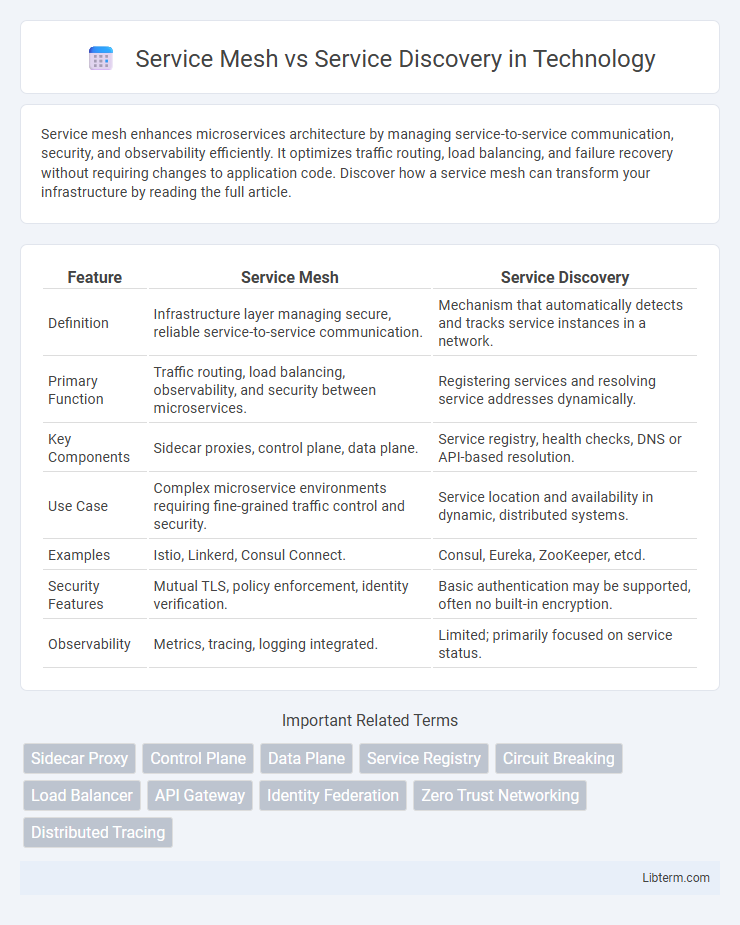Service mesh enhances microservices architecture by managing service-to-service communication, security, and observability efficiently. It optimizes traffic routing, load balancing, and failure recovery without requiring changes to application code. Discover how a service mesh can transform your infrastructure by reading the full article.
Table of Comparison
| Feature | Service Mesh | Service Discovery |
|---|---|---|
| Definition | Infrastructure layer managing secure, reliable service-to-service communication. | Mechanism that automatically detects and tracks service instances in a network. |
| Primary Function | Traffic routing, load balancing, observability, and security between microservices. | Registering services and resolving service addresses dynamically. |
| Key Components | Sidecar proxies, control plane, data plane. | Service registry, health checks, DNS or API-based resolution. |
| Use Case | Complex microservice environments requiring fine-grained traffic control and security. | Service location and availability in dynamic, distributed systems. |
| Examples | Istio, Linkerd, Consul Connect. | Consul, Eureka, ZooKeeper, etcd. |
| Security Features | Mutual TLS, policy enforcement, identity verification. | Basic authentication may be supported, often no built-in encryption. |
| Observability | Metrics, tracing, logging integrated. | Limited; primarily focused on service status. |
Introduction to Service Mesh and Service Discovery
Service Mesh is an architectural layer that manages service-to-service communication, handling load balancing, authentication, and observability for microservices within distributed applications. Service Discovery is the process that enables automatic detection of network locations for service instances, allowing dynamic routing and scaling of services. While Service Discovery focuses on locating services, Service Mesh provides a comprehensive framework to control and secure service interactions across complex infrastructures.
Core Concepts: What is Service Discovery?
Service discovery is a fundamental mechanism that enables automatic detection and identification of network services within dynamic environments such as microservices architectures. It involves maintaining an updated registry of service instances and their network locations to facilitate seamless communication between services without manual configuration. Core technologies supporting service discovery include DNS-based discovery, client-side discovery, and server-side discovery, which collectively enhance scalability, fault tolerance, and load balancing.
Core Concepts: What is a Service Mesh?
A service mesh is a dedicated infrastructure layer that manages service-to-service communication within microservices architectures, providing traffic routing, load balancing, and security features such as mutual TLS. It operates through lightweight proxies deployed alongside application services, enabling observability, resilience, and policy enforcement without modifying application code. Core components of a service mesh include the data plane for handling traffic and the control plane for configuration and management of communication rules.
Key Differences Between Service Mesh and Service Discovery
Service Mesh manages secure service-to-service communication by providing features like load balancing, encryption, and tracing at the network level, whereas Service Discovery primarily identifies and locates services within a distributed system. Service Mesh operates with sidecar proxies to handle inter-service interactions transparently, while Service Discovery leverages registries and DNS to maintain service endpoints and health status. Key differences include Service Mesh's focus on traffic control and observability, contrasting with Service Discovery's role in simple service endpoint resolution and availability monitoring.
How Service Discovery Works in Modern Architectures
Service discovery in modern architectures operates by automatically detecting and mapping network locations of microservices, enabling seamless communication without hard-coded endpoints. It typically relies on a registry where services register themselves and query the directory to locate other services dynamically, ensuring scalability and fault tolerance. Unlike service mesh, which manages traffic control, security, and observability at the network level, service discovery specifically addresses the challenge of service endpoint resolution within distributed systems.
How Service Mesh Enhances Microservices Communication
Service mesh enhances microservices communication by providing a dedicated infrastructure layer that manages service-to-service interactions with features like load balancing, traffic routing, and security policies. Unlike basic service discovery, which primarily registers and locates services, service mesh offers granular control over service behavior, including observability, retries, and fault injection. This comprehensive control ensures reliable, secure, and efficient communication in complex microservices architectures.
When to Use Service Discovery vs. Service Mesh
Service Discovery is ideal for simplifying the dynamic location of microservices within a distributed system, enabling services to find each other efficiently based on DNS or API queries. Use Service Discovery when your primary need is to manage service endpoints for load balancing and basic routing without complex network policies or observability. Service Mesh is suited for environments requiring fine-grained traffic control, advanced security features like mutual TLS, and comprehensive telemetry across service-to-service communications.
Pros and Cons: Service Mesh vs Service Discovery
Service Mesh offers comprehensive traffic management, security features like mutual TLS, and observability for microservices, improving reliability and operational control; however, it introduces added complexity and resource overhead. Service Discovery simplifies locating services within dynamic environments, enabling better scalability and resilience, but lacks the advanced features of traffic shaping, security enforcement, and detailed telemetry found in service meshes. Choosing between Service Mesh and Service Discovery depends on application needs, where Service Mesh suits complex microservice architectures requiring granular control, while Service Discovery fits environments prioritizing simplicity and efficient service registration.
Real-World Use Cases and Adoption Patterns
Service Mesh enhances microservices communication through advanced traffic management, security policies, and observability, widely adopted in large-scale Kubernetes environments like Netflix and Lyft for resilient, secure service-to-service interactions. Service Discovery automates locating service instances using registries such as Consul or Eureka, critical in dynamic infrastructure for load balancing and failover, prevalent in cloud-native applications and hybrid cloud setups. Organizations increasingly combine Service Mesh with Service Discovery to achieve comprehensive service management, optimizing deployment agility and operational reliability in production systems.
Conclusion: Choosing the Right Approach for Your Architecture
Service Mesh provides comprehensive traffic management, security, and observability for microservices, while Service Discovery primarily focuses on locating services within dynamic environments. Selecting the right approach depends on your architecture's complexity, with Service Mesh suited for intricate interactions and advanced policy enforcement, and Service Discovery appropriate for simpler service location needs. Evaluating scalability, security requirements, and operational overhead is crucial to determine the best fit for efficient microservices communication.
Service Mesh Infographic

 libterm.com
libterm.com